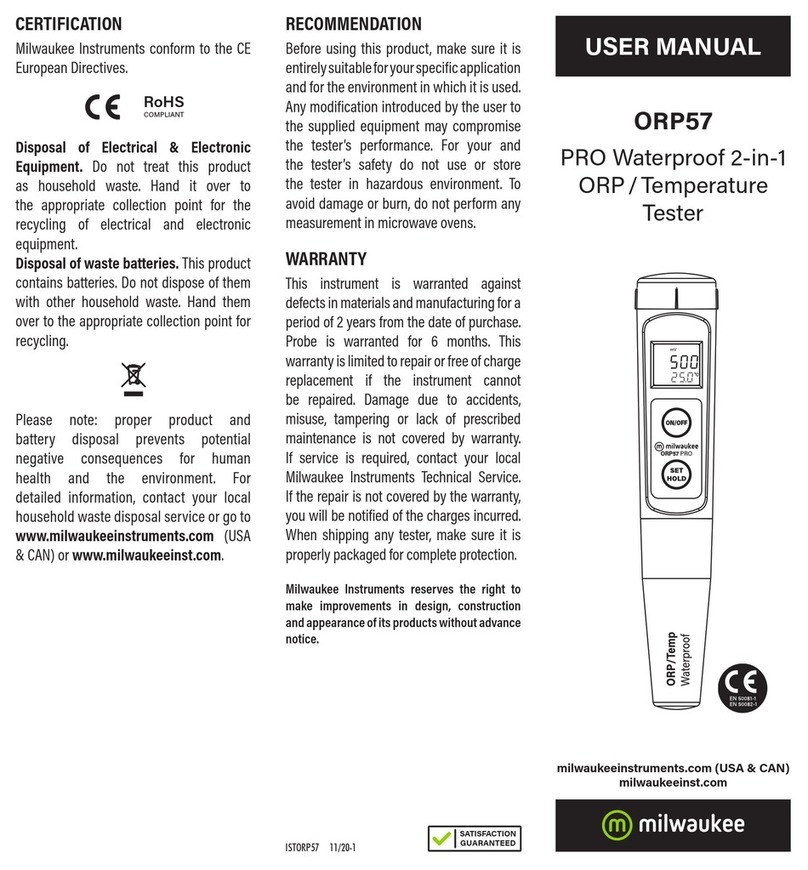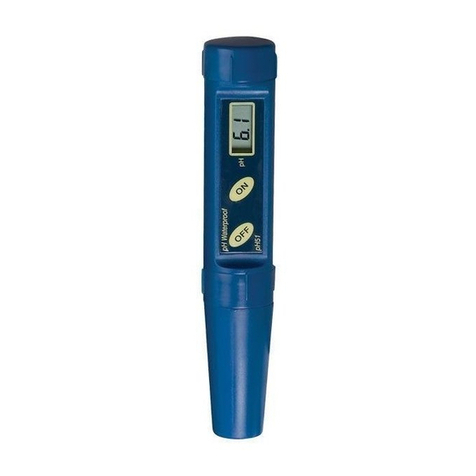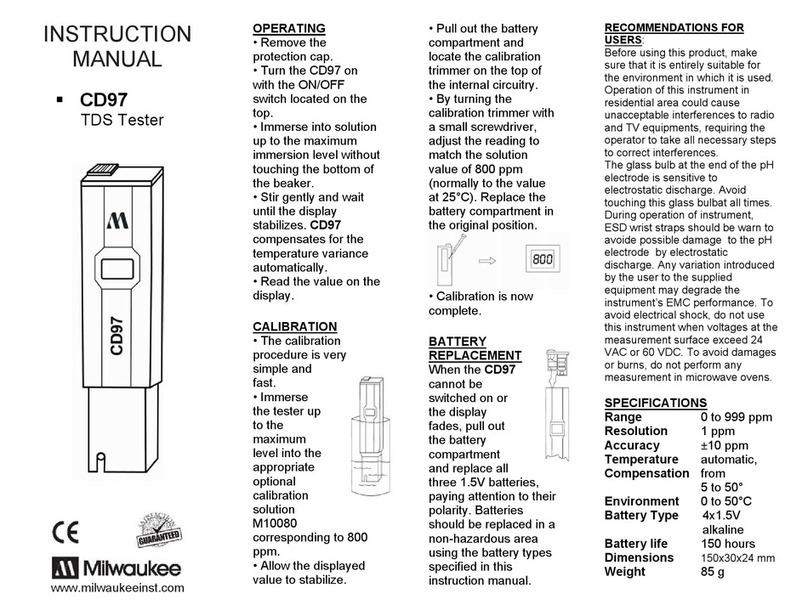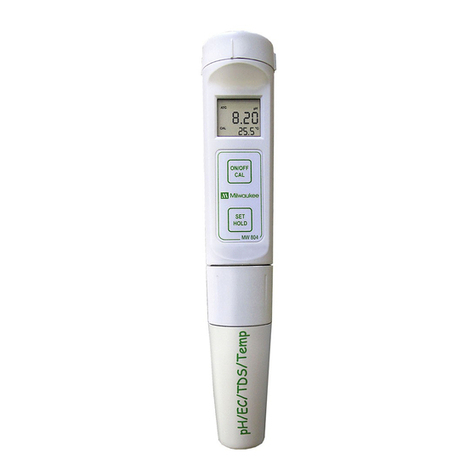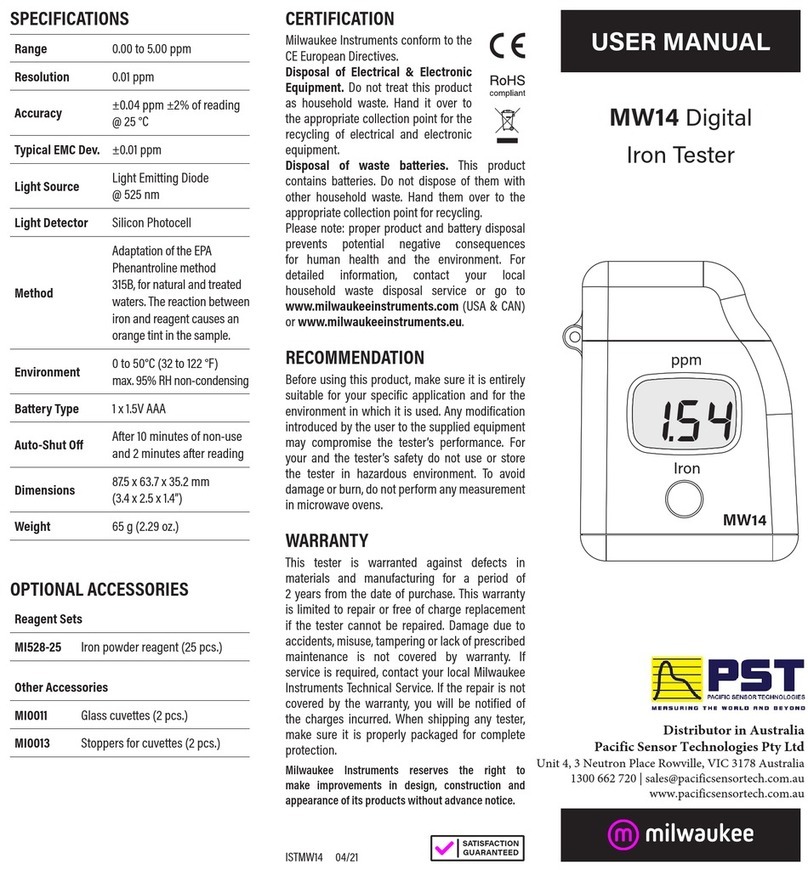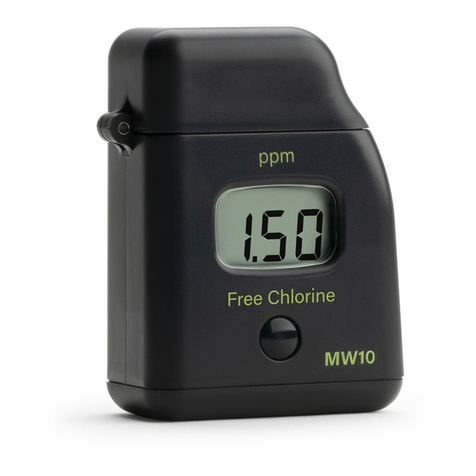
on main LCD
Main LCD
Temperature
reading
Low battery
temperature
Calibration
indicator
Stability
indicator
OPERATIONAL GUIDE
yRemove the probe cap and turn the tester on by
pressing the ON/OFF/CAL button. All the used
segments on the LCD will be visible for 1 second or as
long as the button is pressed.
yImmerse the probe in the solution to be tested and
select either pH, EC or TDS mode with SET/HOLD button.
yStir gently and wait for the reading to stabilize, i.e. the
stability indicator on the LCD turns o. The pH and EC
(or TDS) values are automatically compensated for
temperature and will be displayed on the main LCD,
while the temperature is shown on the secondary LCD.
yTo freeze the display, while in measurement mode,
press and hold the SET/HOLD button. The “HOLD”
message appears on the secondary display and the
reading will be frozen on the LCD.
yPress any button to return to normal mode.
yTo turn the tester o, press the ON/OFF/CAL button.
The “OFF” message will appear on the secondary
display. Release the button.
Notes:
Before taking any measurement, make sure the tester is
calibrated (the CAL tag is on).
After use always turn the tester OFF, rinse the probe with
water and store it with the protective cap.
SETUP
Setup mode allows the selection of temperature (°C
or °F), calibration buer set, in pH mode only,TDS
conversion factor (CONV) and temperature coeicient
(BETA), in EC mode only. To enter the Setup mode, press
the ON/OFF/CAL button until “CAL” on the secondary LCD
is replaced by “TEMP” and the current temperature unit
(e.g. TEMP°C). Then:
In EC and pH mode:
yfor °C/°F selection: use the SET/ HOLD button, then
press the ON/OFF/CAL button to go in the settings
menu and to return to the normal measurement mode.
In EC mode only:
yto change the TDS factor value: after setting the
temperature unit, press ON/OFF/CAL button once to
show the current value (e.g. 0.50 CONV). Select the
desired value by using the SET/HOLD button, then
press ON/OFF/CAL button twice to return to the
normal measurement mode.
yto change the temperature coeicient: after setting
the TDS factor, press ON/OFF/CAL button to show the
current value of the temperature coeicient ß (e.g. 2.1
BETA). Use the SET/ HOLD button to set the desired
value, then press ON/OFF/CAL button to return to the
normal measurement mode.
In pH mode only:
yto change the calibration buer set: after setting the
temperature unit, press ON/OFF/CAL button once and
select the buer set (“pH 7.01 BUFF” for pH 4.01/7.01/10.01
or “pH 6.86 BUFF” for NIST set 4.01/6.86/9.18) by using
the SET/HOLD button. Press ON/OFF/CAL button to
return to the normal measurement mode.
EC MEASUREMENT AND
CALIBRATION PROCEDURE
Select the EC or TDS mode with the SET/HOLD button.
Submerge the electrode in the solution to be tested.
The measurements should be taken when the stability
indicator on the top left of the LCD disappears.
yFor better accuracy, frequent calibration of the tester
is recommended. Calibration is also necessary after
probe replacement, after testing aggressive chemicals
and where extreme accuracy is required. From normal
EC operation mode, press and hold the ON/OFF/CAL
button until the “OFF” message on the secondary LCD
is substituted by “CAL”. Release the button.
yImmerse the probe in the proper calibration solution:
M10031 (1413 µS/cm) for MW803 and M10030
(12.88mS/cm) for MW804.
yOnce the calibration has been automatically
performed, the LCD will show “OK” for 1second and
the tester will return to normal measurement mode.
ySince there is a known relationship between EC and
TDS readings, it is not necessary to calibrate the tester
in TDS if it was previously calibrated in EC mode.
pH MEASUREMENT AND
CALIBRATION
Select the pH mode with the SET/HOLD button.
Submerge the electrode in the solution to be tested.
The measurements should be taken when the stability
indicator on the top left of the LCD disappears.
For better accuracy, frequent calibration of the tester is
recomanded. Calibration is also necessary after electrode
replacement, after testing aggressive chemicals and
where extreme accuracy is required.
yFrom normal operation mode, press and hold the ON/
OFF/CAL button until the OFF message on the secondary
LCD is substituted by “CAL“. Release the button.
yThe instrument enters the calibration mode by
displaying “pH 7.01 USE“ (or ‘‘pH 6.86 USE“ if the NIST
buer set was selected).
yFor a single-point calibration, immerse the electrode
in any buer, i.e. pH 4.01, 7.01 (or 6.86), 10.01 (or 9.18).
yThe tester activates the automatic buer recognition.
If no valid buer is detected, the tester keeps the USE
indication active for 12 seconds, and then replaces
it with WRNG indicating that the sample being
measured is not a valid buer. Otherwise, if a valid
buer is detected, then its value is shown on the main
display, and REC appears on the secondary LCD.
yIf the pH 7.01 (or 6.86) was used, press the SET button
to exit the Calibration mode and the “OK 1” message
will appear on the display. The calibration point is
stored and the tester returns to normal measurement
mode. For better accuracy, it is always recommended
to perform a 2-point calibration.
yFor a 2-point calibration, immerse the electrode in pH
7.01 (or 6.86) buer solution.
yAfter the first point has been accepted, the tester
will then ask for the second buer and the message
“pH4.01 USE” will appear.
yRinse the electrode and immerse it in the second
solution (pH 4.01,10.01 or 9.18).
Notes:
When the calibration procedure is completed, the CAL
tag is turned on.
To quit the procedure and return to the last calibration
data, after entering the calibration mode press the
ON/OFF/CAL button.
yThe secondary LCD displays “ESC” for 1 second and then
the tester returns to the normal measurement mode.
yTo reset to the default values and clear a previous
calibration, press the SET/HOLD button after entering
the calibration mode and before the first point is
accepted.
yThe secondary LCD displays “CLR” for 1second, the
tester resets to the default calibration and the CAL tag
on the LCD turns o.
yIf a valid buer value is detected, the REC message
is displayed and the tester completes the calibration
procedure.
yThe LCD shows the accepted value with the “OK 2”
message and the instrument returns to the normal
measurement mode. Otherwise, if no valid buer is
detected, the tester displays the WRNG message.
PROBE REPLACEMENT
yRemove the protective cap and unscrew the plastic
ring on the top of the probe.
yPull out the MI60P probe and replace it with a new one.
yMake sure the gaskets are in place before screwing
back the ring.
BATTERY REPLACEMENT
When the batteries become weak, the battery symbol
on the LCD will light up to advise that only a few hours
of working time is remaining. The tester is also provided
with BEPS (Battery Error Prevention System), which
avoids any erroneous readings due to low battery level by
automatically switching the tester o. It is recommended
to replace the batteries immediately.
To replace the batteries unscrew the battery
compartment cap and replace all four 1.5V batteries while
paying attention to their polarity.
Make sure the gasket is in place before screwing back the
cap. Batteries should only be replaced in a safe area using
the battery type specified in this instruction manual.





